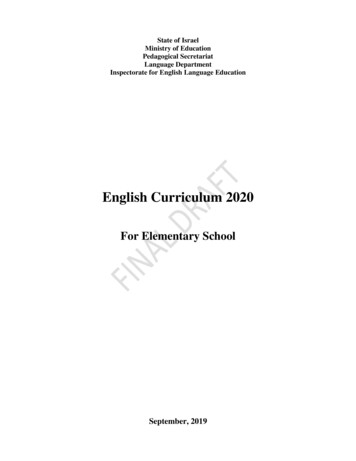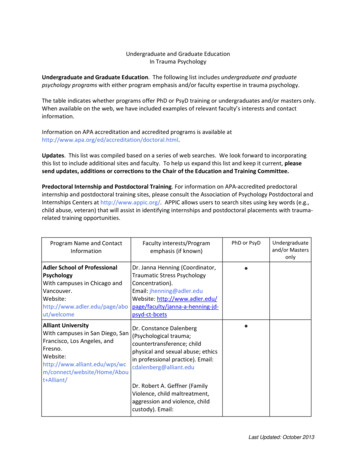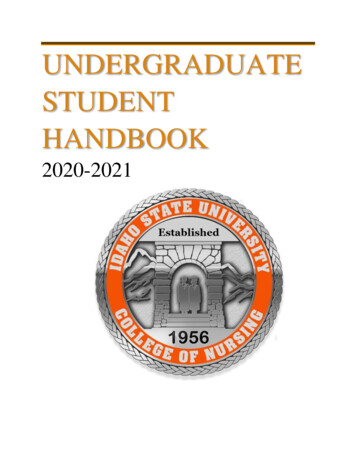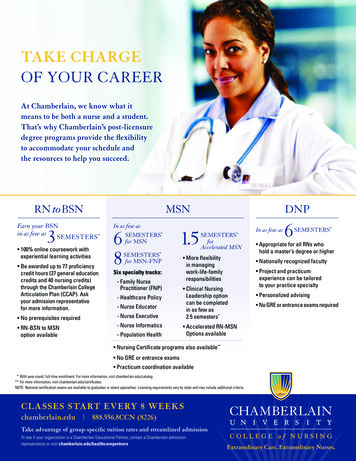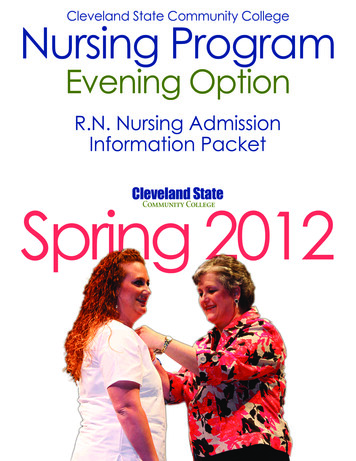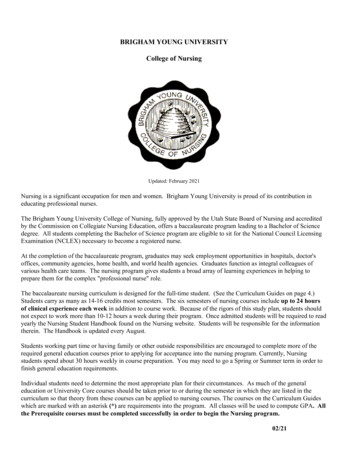
Transcription
TumkurUniversityUndergraduate English Curriculum:Semesters I & IINational Education Policy 2020BoS in English (UG)September, 20210
ourses for Semester I02 - 46Generic English Courses (L2)Word Wonders – Generic English Course for Non-subject SpecificENGL01ProgrammesEffervesense – Generic English Course for Subject SpecificENGL02ProgrammesDiscipline Core Courses02 - 1403 - 0809 - 1415 - 22ENGDSC01 Introduction to Literature16 - 18ENGDSC02 Indian Writing in English – Part I19 - 22Open Elective Courses23 - 31ENGOEC01 Peep into Pixels: An Introduction to Reading Visuals24 - 29ENGOEC02 English for Competitive Exams30 - 31Skill-based Skill Enhancement Courses32 - 46ENGSEC01 English Made Easy33 - 44ENGSEC02 Building Bridges – Introducing Translation45 - 46Courses for Semester IIGeneric English Courses (L2)Lit Lamp – Generic English Course for Non-subject SpecificENGL03ProgrammesPerceive and Ponder – Generic English Course for Subject SpecificENGL04ProgrammesDiscipline Core Courses47 - 9647 - 8048 - 5354 - 8081 - 87ENGDSC03 Introduction to Phonetics and Linguistics82 - 84ENGDSC04 Indian Writing in English – Part II85 - 87Open Elective Courses88 - 96ENGOEC03 The Only Shake-scene in a Countrie: Introduction to Shakespeare89 - 93ENGOEC04 English for Corporate Jobs94 - 961
TumkurUniversityCourses for Semester OneGeneric Language Courses (L2)2
TumkurUniversityCourse Code – ENGL01Word WondersGeneric English Course (L2) for non-subject specific programmesoffered by the Discipline of English Studies under NEP 2020 for Isemester students of Tumkur UniversityBoard of Studies in English (UG)Tumkur University, Tumakuru3
TumkurUniversityOverviewWord Wonders (Course Code – ENGL01) is a three-credit course (three teachingand one tutorial sessions per week) that will be offered in a minimum of fifty-two sessionsto students of non-subject specific programmes that opt for English as one of theirlanguages of study (L2) in the first semester. The course considers language as a mediumfor both mundane communication and evolved thought. Even as it is designed to helpstudents with English language skills, it hopes to help them add nuances to theirresponses to the contemporary world as well. Likewise, the course intends to impartvalues for a productive life through its texts.Texts included in the course have been selected for their potential for nudgingstudents into thoughtful action. Even the ones that are apparently less purposeful alsoare certain to appeal to a majority of students through their shared cultural contextsalone.ObjectivesObjectives of the course include but not limited to:1. Enhancing language abilities2. Helping students engage with the world around qualitatively3. Improving cultural, contextual and aesthetic sensitivity5. Encouraging students to be curious and criticalSpecificationsThe course contents are divided into two parts. Part 1, titled Course Book, isbased on texts of varied length. It consists of ten individual texts of diverse genres, stylesand interests. Thirty sessions are devoted to discussing Part 1.Part 2 is titled Work Book and focuses solely on enriching skills. A minimum oftwenty-two sessions are devoted to teaching Part 2. It is further divided into A.4
TumkurUniversityReceptive Skills and B. Productive Skills. The part on receptive skills aims to improvestudents’ interpretative skills primarily of the written word and visual text. It consists oftwo texts that are delivered over eleven sessions. The part on productive skills intends tohelp students with improving their speaking and writing. This part includes eight groupsof topics, delivered over eleven sessions again, that enrich students’ grammaticalcompetence.Course ContentPart 1: Course Book (30 sessions)1. “Shyness” from the chapter “Lost in the City” in Memoirs by Pablo Neruda (2sessions)2. “Veerappan Conducts Jungle Interviews” from Birds, Beasts and Bandits - 14 Dayswith Veerappan by Krupakar and Senani (translated by S R Ramakrishna) (4sessions)3. “Outsourcing the Storytelling Grandmom” from Culture - 50 Insights fromMythology by Devadutt Pattanaik (2 sessions)4. Excerpt from “The Fingerprints from History”/Introduction to The Language of theGenes by Steve Jones (3 sessions)5. “Interval” by Jayanth Kaikini from No Presents Please: Mumbai Stories (translatedby Tejaswini Niranjana) (5 sessions)6. “The Amateur Scientist” from Surely You’re Joking, Mr Feynman! by Richard P.Feynman (3 sessions)7. Mahatma Gandhi’s Letter to Every Englishman Living in India (Second Letter) (3Sessions)8. “Girl” by Jamaica Kincaid (2 sessions)9. “A Modest Proposal” by Kushanava Choudhury (3 sessions)10. Photo Essay - “Untold Stories of Change, Loss and Hope along the Margins ofBengaluru’s Lakes” by Marthe Derkzen, Arati Kumar-Rao & Anoop Bhaskar (3sessions)5
TumkurUniversityPart 2: Work Book (22 Sessions)A. Receptive Skills: Reading (11 sessions)11. Reading Comprehension - “The Jungle Prince of Delhi” in The New York Times (9Sessions)12. Interpreting Visual Ads (2 sessions)a. Savannah Music Festival poster by Brian Stauffer and Editorial Illustration -An Olympic Catastrophe - by Eiko Ojala for The New York Times (1 Session)b. Break by JWT for Nestle Kitkat and Mouth by Voskhod for Jeternel (1session)B. Productive Skills: Speaking & Writing (11 sessions)13. Introducing Oneself and Others (1 session)14. Requests and Offering Help (1 session)15. Enquiries and Seeking Permission (1 session)16. Offering Instructions and Giving Directions (2 sessions)17. Concord (2 sessions)18. Question Forms (1 session)19. Question Tags (1 session)20. Derivatives: Suffixes and Prefixes (2 sessions)Table 01 showing distribution of sessions across different parts of the coursecontentNo.Topic1Part 1: Course Book2Part 2: Work BookDistribution of Sessions30A Receptive skills11B Productive skills11Subtotal of Part 2226
TumkurGrand Total (Part 1 Part 2)University52References & ResourcesPrint Texts1. Feynman, Richard Phillips. “The Amateur Scientist.” Surely You’re Joking, Mr.Feynman!, 2021, pp. 81–87.2. Gandhi, M K. “The Second Letter” (to Every Englishman Living in India), FamousLetters of Mahatma Gandhi. Ed. R L Khipple, The Indian Printing Works, 1947, pp.33-38.3. Jones, Steve. “The Fingerprints of History.” The Language of the Genes: Biology,History and the Evolutionary Future, UK ed., Flamingo, 1994, pp. 1–18.4. Kaikini, Jayant, (trans. Tejaswini Niranjana). “Interval.” No Presents Please:Mumbai Stories, HarperPerennial, 2017, pp. na.5. Krupakar & Senani (trans S N Ramakrishna). “Veerappan Conducts JungleInterviews.” Birds, Beasts and Bandits: 14 Days with Veerappan, Penguin, 2011,pp. 15–28.6. Neruda, Pablo (trans. Hardie St. Martin). “Lost in the City”. Memoirs. Penguin,1977, pp. 29-54.7. Pattanaik, Devdutt. “Outsourcing the Storytelling Grandmom.” Culture: 50 Insightsfrom Mythology, 1st ed., Element, 2018, pp. 82–84.Online Texts1. Barry, Ellen. “The Jungle Prince of Delhi.” The New York Times [New York], he-jungle-prince-ofdelhi.html.2. Bell, Nick, Russell Ramsey, & Howard Wilmott. “Break”. JWT for Nestle KitKat. Apr.2008. https://www.adsoftheworld.com/media/print/nestle kit kat break3. Choudhury, Kushanava. “A Modest Proposal.” The Caravan, 1 Feb. re.4. Derkzen, Marthe. “Untold Stories of Change, Loss and Hope along the Margins -bengalurus-lakes/.5. Gubaydullin, Andrey. “Mouth”. Voskhod for Jeternel, Aug. ernel mouth.6. ,www.newyorker.com/magazine/1978/06/26/girl.7
TumkurUniversity7. Ojala, Eiko. “An Olympic Catastrophe.” USA, New York, 3 July eiko-ojala/nyxx2016-07-03sr001bs4ce1/.8. Stauffer, Brian. Poster for Savannah Music Festival. Apr. event/.References for Work BookTexts1. Herring, Peter. Complete English Grammar Rules. Create Space Independent Pub,California, 2016.2. Jain Charul, Pradyumnasinh Raj & Yunus Karbharj. English Skills for AcademicPurposes. Macmillan Education. London, 20173. Quirk Randolph, Sidney Greenbaum, Geoffrey Leech &Jan Svartvik. AComprehensive Grammar of the English Language General Grammar. Longman.Online Resources1. ng-composition-skills2. https://www.academia.edu/26724441/A Concise Grammar for English Language Teachers.8
TumkurUniversityCourse Code – ENGL02EffervesenseGeneric English Course (L2) for subject specific programmes offered bythe Discipline of English Studies under NEP 2020 for I semesterstudents of Tumkur University(For BCom, BBA, BCA, BSW, BVA, etc.)Board of Studies in English (UG)Tumkur University, Tumakuru9
TumkurUniversityOverviewEffervesense (Course Code – ENGL02) is a three-credit course (three teachingand one tutorial sessions per week) that will be offered in a minimum of fifty-two sessionsto students of subject specific programmes such as BCom, BBA, BCA, BSW, BVA that optfor English as one of their languages of study (L2) in the first semester. The courseconsiders language as a medium for both mundane communication and evolved thought.Even as it is designed to help students with English language skills, it hopes to help themadd nuances to their responses to the contemporary world as well. Likewise, the courseintends to impart values for a productive life through its texts.Texts included in the course have been selected for their potential for nudgingstudents into thoughtful action. Even the ones that are apparently less purposeful alsoare certain to appeal to a majority of students through their shared cultural contextsalone.ObjectivesThe course helps the students to1. Hone the LSRW (Listening, Speaking, Reading, Writing) skills2. Appreciate literary art3. Get equipped with knowledge of literary devices and genres4. Be endowed with creativity to express one’s experiences5. Get introduced to digital learning tools6. Sensitize oneself with social concerns7. Develop their ability as critical readers and writers.8. Increase their reading speed, presentation skills and their analytical skills.10
TumkurUniversitySpecificationsThe course contents are divided into two parts. Part 1, titled Course Book, isbased on texts of varied length. It consists of ten individual texts of diverse genres, stylesand interests. Thirty sessions are devoted to discussing Part 1.Part 2 is titled Work Book and focuses solely on enriching skills. A minimum oftwenty-two sessions are devoted to teaching Part 2. It is further divided into A.Receptive Skills and B. Productive Skills. The part on receptive skills aims to improvestudents’ interpretative skills primarily of the written word and visual texts. It consists oftwo texts that are delivered over eleven sessions. The part on productive skills intends tohelp students with improving their speaking and writing. This part includes eight groupsof topics, delivered over eleven sessions again, that enrich students’ grammaticalcompetence.Course ContentPart 1: Course Book (30 sessions)1. “The Story of an Hour” Kate Chopin (3 sessions)2. Farewell letter from ‘Che’ Guevara to Fidel Castro (2 Sessions)3. “The Four Facebooks” by Nolen Gertz (4 sessions)4. “A Truck Full of Chrysanthemums” by Jayanth Kaikini from No Presents Please:Mumbai Stories (translated by Tejaswini Niranjana) (3 sessions)5. “The Habit Cure” in The Power of Habit by Charles Duhigg (3 sessions)6. “A Modest Proposal” by Kushanava Choudhury (3 sessions)7. “There is No Such Country” from Tuva or Bust! by Ralph Leighton (3 sessions)8. “You’ve Got to Find What You Love” Commencement Address by Steve Jobs atStanford University (3 sessions)9. Photo Essay - “Untold Stories of Change, Loss and Hope along the Margins ofBengaluru’s Lakes” by Marthe Derkzen, Arati Kumar-Rao & Anoop Bhaskar (3sessions)10. Where The Wild Things Are by Maurice Sendak (3 sessions)11
TumkurUniversityPart 2: Work Book (22 Sessions)A. Receptive Skills: Reading (11 sessions)11. Reading Comprehension - “Shootout at Padi” in Veerappan: Chasing the Brigandby K Vijay Kumar (9 Sessions)12. Interpreting Visual Ads (2 sessions)a. Savannah Music Festival poster by Brian Stauffer and Editorial Illustration -An Olympic Catastrophe - by Eiko Ojala for The New York Times (1 Session)b. Break by JWT for Nestle Kitkat and Mouth by Voskhod for Jeternel (1session)B. Productive Skills: Speaking & Writing (11 sessions)13. Introducing Oneself and Others (1 session)14. Requests and Offering Help (1 session)15. Enquiries and Seeking Permission (1 session)16. Offering Instructions and Giving Directions (2 sessions)17. Concord (2 sessions)18. Question Forms (1 session)19. Question Tags (1 session)20. Derivatives: Suffixes and Prefixes (2 sessions)Table 01 showing distribution of sessions across different parts of the coursecontentNo.Topic1Part 1: Course Book2Part 2: Work BookDistribution of Sessions30A Receptive skills11B Productive skills11Subtotal of Part 2Grand Total (Part 1 Part 2)225212
TumkurUniversityReferences & ResourcesPrint Texts1. Duhigg, Charles. “The Habit Cure”. The Power of Habit. Random House, 2012, pp.na.2. Kaikini, Jayant, (trans. Tejaswini Niranjana). “A Truck Full of Chrysanthemums.”No Presents Please: Mumbai Stories, Harper Perennial, 2017, pp. na.3. Kumar, Vijay K. “Shootout at Padi”. Veerappan: Chasing the Brigand. Rupa, 2017,pp. 231-42.4. Leighton, Ralph. “There is No Such Country”. Tuva or Bust!. Norton, 2000, pp. 137.5. Sendak, Maurice. Where The Wild Things Are. Special Edition, 1 Jan 1967.Online Texts1. Bell, Nick, Russell Ramsey, & Howard Wilmott. “Break”. JWT for Nestle KitKat. Apr.2008. https://www.adsoftheworld.com/media/print/nestle kit kat break2. Choudhury, Kushanava. “A Modest Proposal.” The Caravan, 1 Feb. re.3. Derkzen, Marthe. “Untold Stories of Change, Loss and Hope along the Margins -bengalurus-lakes/.4. ooks.5. Gubaydullin, Andrey. “Mouth”. Voskhod for Jeternel, Aug. ernel mouth.6. Guevara, Ernesto Che. “Farewell Letter from Che to Fidel Castro.” /04/01.htm.7. Kaikini, Jayant. “First Read—From ‘No Presents Please.’” Words Without ini-tejaswini-niranjana.8. Ojala, Eiko. “An Olympic Catastrophe.” USA, New York, 3 July eiko-ojala/nyxx2016-07-03sr001bs4ce1/.9. Stanford University. “Text of Steve Jobs’ Commencement Address (2005).”Stanford News, 12 June 2017, 0. “Steve Jobs’ 2005 Stanford Commencement Address.” YouTube, uploaded byStanford, 8 Mar. 2008, www.youtube.com/watch?v UF8uR6Z6KLc.13
TumkurUniversity11. Stauffer, Brian. Poster for Savannah Music Festival. Apr. event/.12. s/hour/index.html.References for Work BookTexts1. Herring, Peter. Complete English Grammar Rules. Create Space Independent Pub,California, 2016.2. Jain Charul, Pradyumnasinh Raj & Yunus Karbharj. English Skills for AcademicPurposes. Macmillan Education. London, 20173. Quirk Randolph, Sidney Greenbaum, Geoffrey Leech &Jan Svartvik. AComprehensive Grammar of the English Language General Grammar. Longman.Online Resources1. ng-composition-skills2. https://www.academia.edu/26724441/A Concise Grammar for English Language Teachers.14
TumkurUniversitySemester OneDiscipline Core Courses15
TumkurUniversityCourse Code – ENGDSC01Introduction to LiteratureDiscipline Core Course for Honours programme in English offered bythe Discipline of English Studies under NEP 2020 for I semesterstudents of Tumkur University (Adopted from the Report of the SubjectExpert Committee for Model Curriculum Framework)Board of Studies in English (UG)Tumkur University, Tumakuru16
TumkurUniversityCourse DetailsENGDSC01: Introduction to LiteratureNumber of Theory CreditsNo. of Sessions342Course ContentUnits and ContentNo. ofSessionsUnit 1: Introduction to Literature14Chapter 1: What is Literature? - Defining Literature - Why study Literature?Chapter 2: Literature and Society - Literature and LifeChapter 3: Literature and Science - canon - elements of literatureUnit 2: Literary Forms14Chapter 4: Poetry: Lyric, Sonnet, Ballad, Epic, Elegy, Mock-EpicChapter 5: Drama: Comedy, Tragedy, Tragic-comedy, One-act-playChapter 6: Prose: Novel, Novella, Short Story, Essay, Biography, AutobiographyUnit 3: Literary Terms and Figurative Language14Chapter 7: Couplet, Heroic Couplet, Allegory, Alliteration, Assonance, Refrain, Aside,Monologue, Soliloquy, Meta-fiction, Plot, Character, Setting, Narrative techniqueChapter 8: Farce, Simile, Metaphor, Personification, Hyperbole, Satire, Prologue,Epilogue, Art for Art’s sake, Expressionism, Meter and Metrical Devices, Narratology,Romanticism, CanonChapter 9: Simile, Metaphor, Personification, Hyperbole, Onomatopoeia, Euphemism,Irony, Oxymoron, Synecdoche, Understatement, Paradox, Allusion17
TumkurUniversityPedagogyLectures, Seminar, Role play, Group discussion, etc.References & ResourcesText Books:1. Glossary Literary Terms by M H Abrams2. Hudson, William Henry, An Introduction to the Study of Literature. New Delhi,Atlantic 2007.References:1.2.3.4.5.6.7.8.9.Baldick, Chris. The Oxford Dictionary of Literary Terms. OUP, 2001.Bate, Jonathan. English Literature: A Very Short Introduction. OUP.Benett, Andrew. An Introduction to Literature, Criticism and Theory. Routledge.Eagleton, Terry. How to Read Literature. Yale University Press.Eaglestone, Robert. Doing English; A Guide for Literature Students. Routledge,2000. Gopal, Priyamvada. The Indian English Novel; Nation History, andNarration.Hudson, William Henry. An Introduction to the Study of Literature. New DelhiAtlantic, 2007.Mehrotra, Arvind, Ed; An Illustrated History of Indian Literature in English. OrientBlackswan, 2005.Ousby, Ilaih. Ed; The Cambridge Guide to Literature in English, CambridgeUniversity Press. 1983The McGraw-Hill. Introduction to Literature18
TumkurUniversityCourse Code – ENGDSC02Indian Writing in English –Part IDiscipline Core Course for Honours programme in English offered bythe Discipline of English Studies under NEP 2020 for I semesterstudents of Tumkur University (Adopted from the Report of the SubjectExpert Committee for Model Curriculum Framework)Board of Studies in English (UG)Tumkur University, Tumakuru19
TumkurUniversityCourse DetailsENGDSC02: Indian Writing in English - Part INumber of Theory CreditsNo. of Sessions342Course ContentUnits and ContentNo. ofSessionsUnit 1: History of Indian English Literature (Pre-IndependencePeriod)14Chapter 1: The Nature and Scope of Indian English Literature; Charges against IndianEnglish Literature (Reference: M. K. Naik, A History of Indian English Literature(Chapters 1 and 6), New Delhi: Sahitya Akademi, 1980Chapter 2: Pre-Independence Indian English Poetry, Prose, Drama and NovelChapter 3: Introducing authors/texts from the pre-independence era - Raja RamMohan Roy, Toru Dutt, Aurobindo, Swami Vivekananda, Bankim ChandraChattopadhyay, Mahatma Gandhi, Dr B R Ambedkar, Rabindranath Tagore, SarojiniNaidu Henry Derozio, Dean MahometUnit 2: Pre independence Fiction14Chapter 4: Selections from Untouchable by Mulk Raj Anand From Penguin Books PublicationBeginning of the novelPage 1 to 8 (How Bakha’s day begins)Page 38 to 47 (Touching episode)Page 52 to 54 (Temple episode)4Chapter 5: Selections from Raja Rao’s KanthapuraFrom Oxford University press publication 1989Chapter 1 - Introduction to the small village Kanthapura (Page 1 to 13)The Freedom Struggle in Kanthapura (Page 164 to 186)420
TumkurUniversityChapter 6: Selections from R K Narayan’s The GuideIndian Thoughts Publication 2009Chapter 1- (Raju in the ruined temple - Page 5 to 22)Chapter 5 - (How Raju turns out to be a tourist guide and meets Rosie Page 55 to 68)Chapter 11 - (Raju becomes a martyr - Page 234 to 247)6Extra Reading:Krupabai Satthianadhan Saguna: A Story of Native Christian LifeUnit 3: Indian English Poetry, Short Stories and Essays14Chapter 7: PoetryA. Toru Dutt, Our Casuarina TreeB. Sarojini Naidu, Coromandel FishersC. Henry Derozio – To India – My Native LandChapter 8: StoriesA. Mulk Raj Anand - “Barber’s Trade Union”B. Rabindranath Tagore - “My Lord the Baby”C. R. K. Narayan - “A Horse and Two Goats”Chapter 9: EssaysA. M. K. Gandhi - “The Great Sentinel”B. Swami Vivekanand - “Chicago Address”C. B. R. Ambedkar - “A Childhood Journey to Koregaon”References & ResourcesText Books1. Naik, M. K. A History of Indian English Literature. Delhi: Sahitya Akademi, 1992.2. Iyenger, K R S. Indian Writing in English. New Delhi. Sterling Publisher, 1984.References1. Deshmane, Chetan, ed. Muses India: Essays on English-Language Writers fromMahomet to Rushdie. Jefferson, NC, and London: McFarland & Co., 2013.2. Iyenger, K R S. Indian Writing in English. New Delhi. Sterling Publisher, 1984.3. Makarand Paranjape (Ed) Indian Poetry in English, Madras: Macmillan, 19934. Naik, M. K. A History of Indian English Literature. Delhi: Sahitya Akademi, 1992.21
TumkurUniversity5. (M. K. Naik (Ed) The Indian English Short Story: A Representative Anthology,New Delhi: Arnold-Heinemann, 1984)6. Mukherji, Minakshi. The Twice Born Fiction. New Delhi: Heinemann, 1971.7. Narasimhiah, C D. ed Makers of Indian English Literature, Delhi PencraftInternational 20008. Radhakrishnan, N. Indo Anglian Fiction: Major Trends and Themes. Madras:Emerald. 19849. Rao, Krishna. The Indo-Anglian Novels and the Changing Tradition. Mysore: Raoand Raghavan, 1973.22
TumkurUniversitySemester OneOpen Elective Courses23
TumkurUniversityCourse Code – ENGOEC01Peep into Pixels: AnIntroduction to ReadingVisualsOpen Elective offered by the Discipline of English Studies under NEP 2020 for SemesterOne Board of Studies in English, Tumkur University, Tumakuru24
TumkurUniversitySee better, Lear, and let me still remainThe true blank of thine eye.- Kent, King Lear (Act I, Scene i)OverviewPeep into Pixels: An Introduction to Reading Visuals (Course Code – ENGOEC01) is athree-credit Open Elective course that will be offered in forty-five teaching sessions to studentsof any discipline. The course introduces to students the world of visuals as an academic subject.It includes discussions on photographs, posters, print ads, paintings and written texts related toeach of these in its contents. The scope of this course is limited to static images/visuals.The course is introductory and is designed to act no more than a curtain-raiser. The focus of thiscourse is to enable students to describe, analyze and interpret visual artwork intelligently andinsightfully. This is a course primarily in reading and is not necessarily intended to help studentsproduce or design works of art. Since the course is offered as an open elective it is light ontheories of reading and encourages free ranging responses.Objectives1. To enable students to appreciate creative visuals2. To enable students to develop an inquiry into creative visuals3. To help students respond to creative visuals by applying their imagination, analyticalskills and critical thinking4. To nudge students towards combining instinctual responses with contextual informationwhile interpreting visualsSpecificationsThe course contents are divided into two parts.Part 1, titled Introductory Reading, which attempts to incorporate written prose texts thatoffer an understanding of visual texts. It consists of six individual prose pieces including excerptsfrom chapters as well as complete chapters in books on visuals. Fifteen out of the total forty-fivesessions are devoted to discussing Part 1.Part 2 is titled Reading Visuals and is divided further into three parts: A. Paintings, B.Photographs and C. Posters & Ads. Some items in Part B: Photographs include short written25
TumkurUniversityexplanatory material with them. In Part 2, twelve sessions are dedicated to discussing A.Paintings, ten sessions to B. Photographs and eight sessions to C. Posters & Ads.Course Content & ResourcesPart 1: Introductory Reading (15 Sessions)1. Chapter 1 (page 7 to 33), Ways of Seeing, John Berger, BBC & Penguin Books 19772. Chapter 7 (page 129 to 154), Ways of Seeing John Berger, BBC & Penguin Books 19773. Excerpts from Chapter 1: “In Plato’s Cave” from On Photography Susan Sontag, RosettaBooks, 2005.4. “What is a Designer?” (3 pages) in Chapter 2: Designers and Stylists, Design As Art,Bruno Munari, Trans. Patrick Creagh, Penguin Modern Classics 20085. Chapter 4: “Graphic Design” (9 pages) Design As Art, Bruno Munari, Trans. PatrickCreagh, Penguin Modern Classics, 2008.6. “The Environmental Impacts of Consumer Advertising.” Adfree Cities, 21 May mpacts-consumerism-advertising.Part 2: Reading Visuals (30 Sessions)A. Paintings (12 Sessions)1. Ships on a Stormy Sea by Willem van de Velde the Younger ns/d/d2/Willem van de Velde the Younger%2C Ships on a Stormy Sea %28c. 1672%29.jpg2. Dutch Boats in a Gale (“The Bridgewater Sea Piece”) by Joseph Mallord William Turner(1801) https://commons.wikimedia.org/wiki/File:Joseph Mallord William Turner Dutch Boats in a Gale - WGA23163.jpg3. Woman with a Parasol/Madame Monet and Her Son/ The Stroll by Claude Monet (1875)https://en.wikipedia.org/wiki/Woman with a Parasol %E2%80%93 Madame Monet and Her Son#/media/File:Claude Monet - Woman with a Parasol Madame Monet and Her Son - Google Art Project.jpg4. A Bar at the Folies-Bergère by Édouard Manet (1882)https://en.wikipedia.org/wiki/A Bar at the FoliesBerg%C3%A8re#/media/File:Un bar aux FoliesBerg%C3%A8re d'E. Manet (Fondation Vuitton, Paris) (33539037428).jpg5. Christina’s World by Andrew Wyeth 6
TumkurUniversity6. Bharat Mata by Abanindranath Tagore (1905)https://en.wikipedia.org/wiki/Bharat Mata (painting)#/media/File:Bharat Mata by Abanindranath Tagore.jpg7. Bride’s Toilet by Amrita Sher-Gil (1937) ade-oil-painting-oncanvas8. Days of glory by Satish-Gujral ays-of-glory-by-satish-gujral/B. Photographs (10 Sessions)1. Behind the Gare Saint-Lazare by Henri Cartier-Bresson, 1932https://en.wikipedia.org/wiki/Behind the Gare Saint-Lazare#/media/File:Henri CartierBresson - Behind the Gare Saint-Lazare, 1932.jpg2. The Moonrise, Hernandez, New Mexico by Ansel Adams, 1941https://www.moma.org/collection/works/539043. D-Day, Robert Capa, 1944 rmandy-france-june-6th-1944/a. “Robert Capa and Omaha Beach.” Imperial War ha-beach4. Gandhi and the Spinning Wheel by Margaret Bourke-White ndhi-spinninga. “Gandhi and His Spinning Wheel: The Story Behind a Famous Photo.” LIFE, 2Nov. 2020, the-storybehind-an-iconic-photo5. Alfred Krupp by Arnold Newman, 1963 krupp-essen-germany6. Gary Winogrand’s Central Park Zoo, New York, h/262314a. Papageorge, Tod. “About a Photograph: New York, 1967, by Garry Winogrand.”Open Edition Journals, 30 Dec. ca/70847. Delhi-Mumbai Train, by Raghu Rai, 4/12/16/raghu-rai/8. Mother and Child during Monsoon by Steve McCurry, -29. 99 Cent, Andreas Gursky, 1999 t10. The Situation Room, Pete Souza, 2011https://en.wikipedia.org/wiki/File:Obama and Biden await updates on bin Laden.jpg27
TumkurUniversitya. Johnson, Ken. “The Power of the Situation Room Photograph.” The New YorkTimes, 6 Feb. nson.htmlC. Posters & Ads (8 Sessions)1. D&AD Campaign, (single) 95 Percent: The Advertising Academy, October 2006 (“95Percent: The Advertising Academy: D&AD.” Ads of the World, 7 Aug. 2007)https://www.adsoftheworld.com/media/print/95 percent the advertising academy dad2. The Identity of Young Chennai, JWT for The Times of India, April 2009https://www.adsoftheworld.com/media/print/the times of india the identity of youngchennai3. Keys, Google, June 2009 https://www.adsoftheworld.com/media/print/google keys4. World Cup Poster, Edel Rodriguez up-poster5. Bike, BBDO for ThaiHealth, September health bike6. Drive Carefully (Set of three - Stairs, Swing, & Pool, DDB for Volkswag
6. “The Amateur Scientist” from Surely You’re Joking, Mr Feynman! by Richard P. Feynman (3 sessions) 7. Mahatma Gandhi’s Letter to Every Englishman Living in India (Second Letter) (3 Sessions) 8. “Girl” by Jamaica Kincaid (2 sessions) 9. “A

